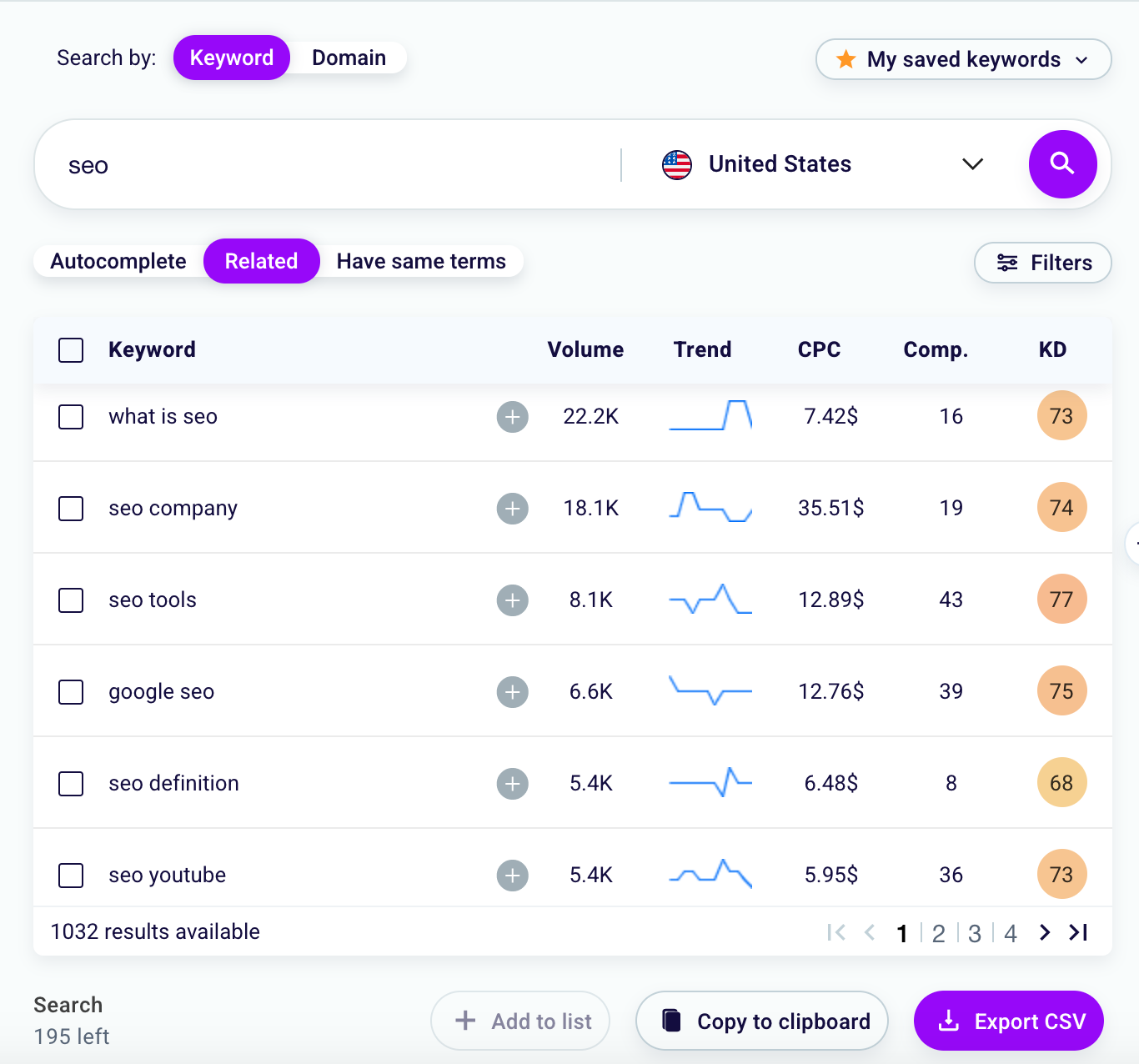Guide to SEO Copywriting
So, you have decided to become a Copywriter. An SEO Copywriter no less.
Good for you! Are you ready to work on editorial plans, on keyword search? Are you prepared to make your way through title tags, headings, and editing?
Excellent. But read this article first, you may learn a thing or two about the craft.
A definition of SEO copywriting
SEO copywriting is the activity of writing content for both humans and search engines. No, not just search engines. We said both. If you write for humans and provide them with useful information – you’re already writing for search engines, too. You only need to pay a little more attention to some details.
But you may ask: what makes my articles optimized SEO-wise?
Well, ask no more! We’ll parse through all phases of a good SEO copywriting. Let’s begin with the things you must do before starting to write.
What to do before writing
So, are you thriving about writing your first blog post? Hold your horses a little bit longer.
Before starting to write, you should do a little bit of research about what you should write.
You should ask yourself a few questions.
- What your public could find exciting reading?
- What are the hottest topics in your industry?
- What are your competitors writing about, and how?
- What is your uniqueness?
We don’t have the answers for you, but we can teach you how to find them yourself. And that’s what we’re going to do. Ready? You’re about to learn how to:
- prepare the brief;
- do the keyword search and create the editorial plan;
- choose the right tone;
- build the structure.
How to do the brief
Whether you’re working for a customer or your brand, there’re a few questions you should ask your client (or yourself). These questions make the brief, a document that will guide you in creating the editorial plan:
- In which industry you’re working?
- What is your target?
- Why should someone choose you over a competitor?
- Who are your competitors?
- What are your business goals? (increasing leads, conquer another market share, rebranding.)
- What goals do you want to hit through the blog?
- What are your strengths and weaknesses?
- What are the unique features of your product or service?
If you work for someone else, it could be quite a task to get information, because some companies have no idea of what they are and where they want to go.
Then you have to choose what do you want to write. Once having decided on the general theme, you need to find the topics for single articles. In brief, you need an editorial plan.
What is the editorial plan?
The editorial plan is the list of the topics and the articles that are going to tackle them. It is an essential tool for your SEO copywriting job. It is a reminder of who you are, who is your audience, and how you are going to keep it close and interested in your content.
How to create it
The most common way to create an editorial plan is to open a new spreadsheet. There, you put the primary and secondary topics of each blog post.
How to find the topics?
First of all, keep in mind who your audience is. What could interest your target? Now you have an idea of the general topic. How to get more specific?
Then, ask yourself the search intent you want to intercept.
Also, keep in mind the pros and cons of broad, middle-tail, and long-tail keywords.
Now you’re ready for keyword research!
How to do keyword research
SEO copywriters can count on a good number of useful, free tools to do their keyword research.
- Google Search and related search: start with writing the topic you’re interested in on Google’s bar. The search suggestions can give you a hint of the long tail keyword you may want to use. Also, the related searches can provide you with a good number of secondary keywords.
- Ubersuggest: can tell you how much volume and competition a keyword has.
- Answer the public: can provide you with new keyword ideas, in the shape of questions.
- Google Trends: with this tool, you can discover the interest of a given topic or keyword over time. In this way, you can determine if the blog post you are about to write tackles a hot topic or not.
Use the Keyword Explorer!
You can use all the tools mentioned above, and that’s great.
Or, you can use SEO Tester Online’s Keyword Explorer.

It brings the functions of these tools in one place. With it, you can discover your primary and secondary keywords in a fraction of the time.
Write with taste: choose the format
Now you have to decide the very nature of the article you are about to write. What is its format? Is it going to be long and full of information? Or is it going to brief? Hubspot’s Rick Burnes has the perfect recipe.
- 🥣 Raisin bran posts: useful, brief posts with high engagement and a daily publication, like recipes. Be sure they’re useful and engaging;
- 🥬 Spinach posts: articles that make you an opinion leader. Most of the times are thoughts about the changes in your industry;
- 🍖 Roast posts: very long posts filled with information. They take much time to write and read, like this one. They can boost your reputation and get you much traction.
- 🌶 Tabasco posts: they spice up the conversation by launching controversial and often divisive messages. They have, most of the time, a bold, incendiary title.
- 🍫 Chocolate cake posts: light-hearted articles. It consists of funny stuff with videos and cartoons. They aim to entertain the reader and add some levity to your editorial plan.
So, what kind of articles you should write? Our advice is a bit of each; only you know the right quantity for each ingredient. Be careful with all that tabasco, however.
You can also update your spinach and roast posts with new information instead of writing new ones. In this way, you have your pillar articles.
Structure
There is the last thing to do before starting to write. That is, to prepare the structure of your article. It may seem a waste of time, but it helps to save a lot of it.
The structure is a simple text document where you outline what you are going to write.
- Start with the Call to Action if you have one. It’s an excellent way to put your writing in the right direction.
- Make a list of paragraphs. Use the titles you want to use in your article. Since we are talking about SEO Copywriting, specify the heading tag you are going to use.
- Outline the topics you want to deal with under each paragraph title.
Here’s the structure of the article you are reading:
What to do when writing
If you didn’t give up with the preliminary work, we have good news: it’s time to write.
In this paragraph, you are going to discover what makes excellent SEO copywriting, from titles to the right use of keywords.
Anatomy of an SEO-friendly title
We already write about titles and headings in SEO. Here is a quick reminder.
- Ask first: “what is my goal?” “Who are my readers?” “What are they looking for?”.
- Heading tags should include your main keyword or related ones. They must make sense to humans, too.
- Avoid keyword stuffing. It is the excessive repetition of the same keyword.
- Heading tags follow a decreasing order: start with an H1 tag, and go on with H2, H3.
- Use just one H1 tag.
- Always consider keyword prominence and keyword proximity.
- The SEO title must be less than 70 characters and 12 words long.
Also, some characteristics make titles more compelling.
- Benefit promise («Increase your income with this one simple rule»);
- How-tos;
- Numbers («the ten rules to…»);
- Questions («Do you want to become rich while sleeping?»);
- Empathy/a shared problem («I know how it feels when you are single and broke»);
- Promise pleasure («Try not to laugh!»)
- Avoid pain («You don’t have to get stuck in a job you hate»).
Avoid keyword stuffing
SEO Copywriting is not just a matter of writing the right keywords as much as possible.
SEO Copywriting is about writing well. And use keywords, sure.
But you must focus on producing something useful and easy to read. Search engines prize this. Not the repetition of the same phrases again and again.
Instead of doing keyword stuffing, use synonyms. Google recognizes them. And it penalizes keyword stuffing, by the way.
Language!
We hope we stressed enough the importance of writing well. But what can you do? Here are some tips by Stephen King himself in his book “On Writing.”
Use simple vocabulary
There is no reason to dress up your language with pompous, pretentious words. Whatever you are writing, your goal is to communicate, after all. And it’s easier to do it when you use words that anyone can understand.
Use simple grammar
The same goes for grammar. Whatever is your confidence (and your reader’s) with it, it’s probably too late to make significant improvements.
So, stick with simple grammar. You can write most of the blog posts with simple tenses and using straightforward phrases.
All you need is two things: a subject that performs and action. The verb expresses the action. That’s it.
It worked for Hemingway, and he won a Nobel prize. It can work for you, too.
Write short sentences
You can also write longer sentences, of course, but try to keep them short. Every clause must contain just one piece of information.
Break your text into paragraphs.
And keep them well separated. Try to look a block of text without any white space between paragraphs. You don’t even need to read it to know it is going to be quite a challenge.
Use the active form to give your sentence more action.
Mr. King writes: «Two pages of passive voice […] make me want to scream. It’s weak, it’s circuitous, and it’s frequently torturous, as well».
Avoid adverbs
As well as passive voice; they make your language weak. Also, they’re often unnecessary and make the reader think you’re not sure about what you’re writing.
Try to rule out all the adverbs from any text. There is a good chance that the meaning would not have suffered any loss.
Ordered lists
they make the reading more comfortable, and Google likes them a lot. Think about how featured snippets look.
Circularity
You can use a metaphor or any other image at the beginning of your article. Then use it all through your blog post: a bit in the middle and especially at the end. It works as a theme and makes reading engaging.
What to do after writing
Now you’ve finished writing. Ready to publish? Assuming you’ve done excellent proofreading, there are still a few things left.
- Create an optimized snippet, with a good SEO title and a good, self-explanatory meta description with the right call to action;
- Optimize the Open Graph;
- Use images that are coherent with the topic and use alt texts to describe what they show
- Share your article on your social networks;
Use SEO Editor
While Keyword Explorer is your companion on the pre-writing stage, SEO Tester Online’s SEO Editor is perfect for the writing and post-writing stages. It has everything you need from a word processor, plus many tools for SEO copywriters.
- You can select primary and secondary keywords;
- check how much your text is SEO-friendly in real-time;
- Edit snippets and Open Graphs;
- Check the keyword density.






